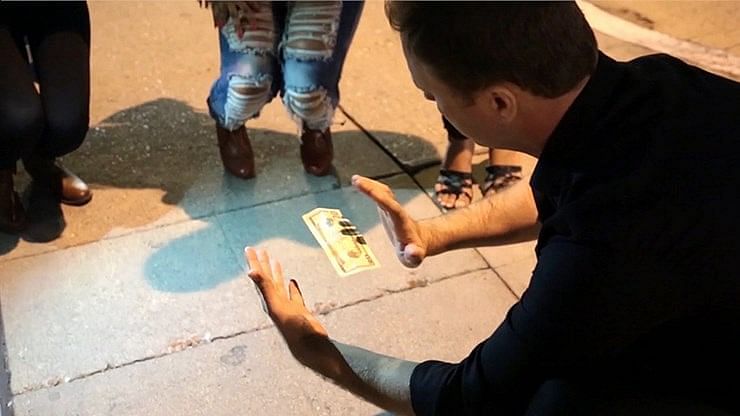How to Animate and Levitate Items
The ability to animate or levitate objects is one of the most powerful magic tricks a magician can perform. It is no coincidence that nearly every magician has their own version of The Haunted Deck, Floating Bill or Floating Ring. So, how do you animate or levitate an item?
History of using Invisible Thread for animation and levitation
Using an invisible piece of thread for the animation, suspension and levitation of objects dates back centuries. According to Conjuring Credits, a late 15th century notebook written by a monk at Syon Abby in Middlesex named Thomas Betson discusses using a fine strand of woman’s hair to move a blown egg or suspend a coin in air. A description of a magic trick performed with invisible thread can also be found in a Japanese book from 1755 called Senjutsuya Hanraku (The Hermit’s Nighttime Magic).
What is Invisible Thread made of?
The most basic description of invisible thread is a thin piece of thread that is imperceptible to the human eye and can be used by magicians to levitate or animate small, lightweight objects. As noted, the most early applications of invisible thread were performed with long strands of hair. Chinese and Japanese magicians were also known to extract strands from the cocoons of silkworms.
Today, invisible thread is typically made of nylon, silk, kevlar or a durable elastic thread material. Magicians often buy large batches of unstripped invisible thread that they can separate into individual threads when needed. Pre-stripped invisible thread is also available.
How to use Invisible Thread?
Invisible thread can be attached to any object with tape or magician’s wax like Mesika Wax. It can be separated and attached by hand or fed through an invisible thread reel (ITR) like Yigal Mesika’s Tarantula 2 for easy access.
What is the difference between invisible thread and magic loops?
Around the turn of the 20th century, magicians began exploring the possibility of looping a length of thread into an invisible thread loop. Some of the earliest applications of this prop include Will Goldston's “Gravity Defied”, a “Magnetic Cards” style card trick released in 1915, and William F. Hanna's “A Unique Color Change” in 1916.
Despite their early adoption, magic invisible thread loops weren’t commonplace until magician Finn Jon introduced an amazing new prop called “Revolutionary Thread” using innovative elastic thread. These magic loops eventually become popularized by Yigal Mesika as “Loops”, a remarkably powerful and versatile prop trusted by professional magicians like Dynamo, David Blaine, Cyril and Criss Angel.
Yigal Mesika’s Loops transformed how magic with invisible thread was performed. They are incredibly easy to use for classic tricks like the Haunted Deck and Floating Bill, and can be used for a variety of other innovative magic tricks discussed in the incredible Loops Deluxe 2-DVD Set. As they come ready to go and can be worn on your wrist undetected, Loops are incredibly practical and are perfect for impromptu magic. Many magicians like Justin Willman often carry Loops with them everywhere they go in a special Innercircle carrying case.
What are the best magic tricks using magic loops or invisible thread?
Some of the most popular tricks to perform with Loops or invisible thread are the Floating Bill, Floating Ring, Rising Card and Pencil in Bottle.

Other applications include the Haunted Deck, an amazing magic trick where a deck of cards magically cuts itself in half to reveal a card selected by a spectator. Although its roots date back to the early 1800’s, this incredible effect was popularized with a trick released by Al Baker in the 1930’s called “The Pack that Cut Itself”. While many variations of the Haunted Pack have been developed over the years, it has never been more popular than it is now thanks to David Blaine and Dynamo using Loops to perform it on their TV specials.
Another common effect with invisible thread is “The Dancing Card”. This idea of an animated playing card goes as far back as what many believe to be the first ever recorded book of magic tricks The Discoverie of Witchcraft in 1584. Perhaps the most well known entry in this field though is Bob Hummer's marketed Whirling Card (later known as The Hummer Card).
Many famous magicians, particularly mentalists like Derren Brown have also used invisible thread for Invisible Touch or PK Touch routines. This an eerie effect where a spectator feels a sensation of being lightly touched, despite no physical evidence that anyone ever touched them. The invisible touch concept can be traced back to the days of Howard Thurston. However, it gained mainstream fame when mentalist Lior Manor started using Yigal Mesika’s Loops to achieve this effect. Loops are now the most common prop for performing Invisible Touch or PK Touch routines.
Add Magic Loops to cart (9.95$9.95)
Or, view more information
